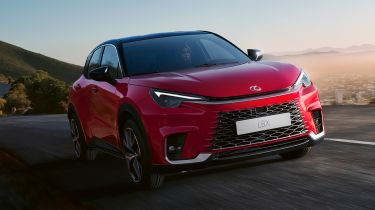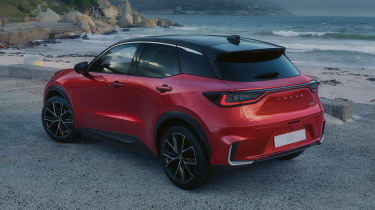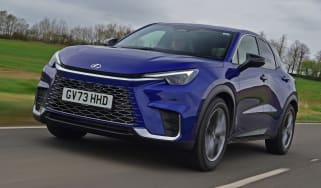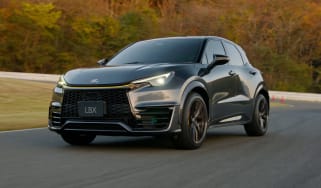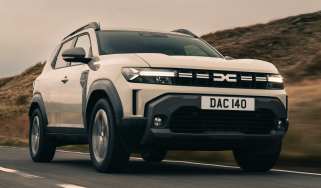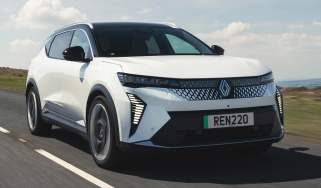New 2023 Lexus LBX priced from £29,995
The LBX is the smallest model in the Lexus lineup
Lexus has revealed the LBX – a small SUV destined to rival the likes of the Audi Q2 and DS 4 in the compact crossover sector. Six LBX variants will be offered, with orders starting from October and deliveries from March 2024.
Designed for European customers, the Lexus LBX sits on parent firm Toyota’s GA-B platform, which underpins the Yaris Cross. However, Lexus says the LBX has been re-engineered to deliver the refinement and the driving experience necessary for one of its cars. There’s also a big focus on design, quality and personalisation, with a new Lexus Bespoke Build programme.
The LBX’s design reinterprets the firm’s ‘Spindle grille’, with a new mesh section. Above this is a narrow strip that links the headlights. At the rear, the full-width LED light bar includes a raised centre section across the boot lid to visually help give the car a lower centre of gravity, according to the brand’s design team.
The core trim levels include the entry-level Urban, Premium, Premium Plus and Takumi, Premium Plus Design and Takumi Design. The LBX will also come in four ‘atmospheres’. In effect, these are trim packs that change the look and feel of the car, but don’t differentiate so much in terms of kit. The Elegant atmosphere offers a leather-free interior and comes with 18-inch alloy wheels, while Relax focuses on “luxurious elements and premium style”. Emotion is the sportiest option in the line-up, featuring a bi-tone roof, while Cool balances Emotion’s urban, sporty appeal with a little more luxury.
A limited ‘Original Edition’ will be made available at the beginning of the LBX’s launch, with just 250 examples being built. It gets a unique Sonic Copper bi-tone finish, with matt black 18-inch wheels, bumper inserts, rear pillar decals and special badging.
Full pricing is yet to be revealed for the LBX so we only know that range starts from £29,995 for the Urban version. It’s well-equipped, though, featuring 17-inch alloy wheels, LED headlights with automatic high beam and a Lexus Link Connect multimedia system with 9.8-inch touchscreen. Dual-zone climate control, wireless Apple CarPlay and wired Android Auto, front and rear parking sensors and rear-view camera are also standard equipment on the LBX.
Next up is the Premium, with heated front seats in synthetic leather upholstery, tinted rear windows and a wireless smartphone charger. Upgraded safety systems come in the form of a pre-collision system with a driver monitor, rear side monitor and blind-spot assist.
Above this is the Premium Plus, adding 18-inch wheels, a powered bootlid, a 12.3-inch driver’s display, head-up display and an air purification system. The Premium Plus Design further adds two-tone paintwork, diamond-cut alloys and perforated upholstery with red stitching.
Takumi models get an uprated sound system, a powered and memory driver’s seat, multi-colour interior ambient lighting, park assist and adaptive LED headlights. The Takumi Design offers bi-tone paintwork, bespoke 18-inch alloys and a combination of synthetic suede and leather upholstery.
One feature that comes fitted as standard to all LBX models, however, is Lexus’s Safety System+. This includes adaptive cruise, lane assist, collision warning with autonomous braking, blind-spot monitoring and cross-traffic alert, plus Lexus’s e-latch door release and Safe Exit Assist tech that will stop occupants opening the door into the path of an approaching car or cyclist.
Underneath the skin is a 1.5-litre three-cylinder petrol engine with a CVT automatic gearbox. They’re supported by a new bi-polar Nickel Metal Hydride battery, which chief engineer Kunihiko Endoh says is lighter and more compact than a regular NiMH battery and allows faster charging and discharging.
Speaking to Auto Express, Endoh-san said that this means the battery output can be greater to capitalise on a larger e-motor than in the Yaris Cross. In the LBX that should translate into sharp acceleration from a standstill (it’s clear the car is designed for urban use) and give a greater connection to the powertrain, reducing the rubber-band feel you can get with a CVT. “It’s about delivering linear acceleration,” he told us. “The faster response of the e-motor means the ICE and electric are working in balance. It should run more than 50 per cent of the time in electric mode in city driving.”
Tweaks to the suspension have resulted in an agile, stable drive, Lexus says. The car uses MacPherson struts at the front and a torsion beam at the rear on two-wheel-drive cars, with a double wishbone back axle for all-wheel-drive models. To help body control and stability, Lexus has also fitted Vehicle Braking Posture Control, which automatically uses the brakes to reduce pitching. The car’s wheelbase is 20mm longer and its track is wider than the Yaris Cross’s, too.
When we sat inside the LBX, we thought the packaging could be better. The rear seats are cramped and small rear doors mean getting in and out isn’t the easiest. At 332 litres in the front-wheel-drive car, boot space is fair, but this drops to 255 litres in the E-Four model due to its extra motor under the floor. Storage inside is okay, with one cup-holder in front of the clever gear selector that’s shared with the NX, and one behind, under an armrest that slides and tilts to also reveal another storage area. However, there are no seat pockets or cup-holders in the rear.
Q&A with Dimitris Tripospitis
Head of Lexus Europe

Lexus’s European boss outlines how important the new small, luxury SUV is for the brand.
Q: What does the LBX mean for Lexus?
A: “It’s for the city and usage here. It’s relevant. It opens up Lexus to a new segment.”
Q: Is one of the goals for this car to lower the average age of Lexus’s European buyers?
A: “There is no age category. We are targeting three categories: Lexus Loyals, Aware of Lexus, and New to Lexus. It’s more about conquesting non-Lexus drivers rather than saying we are going for younger, because the LBX is also for existing Lexus owners who want a smaller car for the city. It’s about utilisation, not age.”
Q: Are you looking to mop up some sales that were taken by the old CT? What does LBX mean for UX?
A: “Hopefully we will retake some of those sales. LBX is smaller than UX, even though the feeling of the interior space is a sector up. UX serves a different purpose.”
Q: There’s a lot of big-car tech on the LBX – what does this mean for price? The sector is so competitive.
A: “You’re telling me! It’s work in progress, but it’s not an entry car; it’s a full premium car that’s four metres long. It’s an expensive car to build, but it can’t have an expensive price. We’re working on a competitive price.”
Now read more about the top 10 best small SUVs and crossover cars to buy in 2023...

